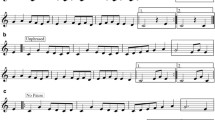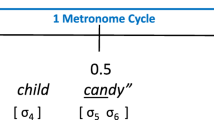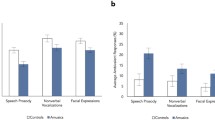Abstract
Reports of a relatively high prevalence of absolute pitch (AP) in autistic disorder suggest that AP is associated with some of the distinctive cognitive and social characteristics seen in autism spectrum disorders. Accordingly we examined cognition, personality, social behavior, and language in 13 musicians with strictly defined AP (APS) and 33 musician controls (MC) without AP using standardized interviews and tests previously applied to identify the broad autism phenotype seen in the relatives of autistic probands. These included the Pragmatic Rating Scale (PRS) (social aspects of language) the Personality Assessment Schedule (PAS) (rigidity, aloofness, anxiety/worry, hypersensitivity), and WAIS performance subtests (PIQ). On the basis of their behavior in the interviews, subjects were classified as socially eccentric, somewhat eccentric, or not eccentric. Forty-six percent of the APS, but only 15% of the MC, were classified as socially eccentric (p < .03). APS but not MC showed higher scores on block design than on the other PIQ tests (p < .06), a PIQ pattern seen in autism spectrum disorders. Although APS and MC did not differ significantly on other measures it is of note that APS mean scores on the PRS and PAS (5.69, 4.92) were almost twice as high as those for the MC (3.03, 2.45). Thus, musicians with AP show some of the personality, language, and cognitive features associated with autism. Piecemeal information processing, of which AP is an extreme and rare example, is characteristic of autism and may be associated as well with subclinical variants in language and behavior. We speculate that the gene or genes that underlie AP may be among the genes that contribute to autism.
Similar content being viewed by others
REFERENCES
Baharloo, S., Johnston, P. A., Service, S. K., Gitschier, J., & Freimer, N. B. (1998). Absolute pitch: An approach for identification of genetic and nongenetic components. American Journal of Human Genetics, 62, 224–231.
Baharloo, S., Service, S. K., Risch, N., Gitschier, J., & Freimer, N. B. (2000). Familial aggregation of absolute pitch. American Journal of Human Genetics, 67, 755–758.
Ehlers, S., & Gillberg, C. (1993). The epidemiology of Asperger syndrome: A total population study. Journal of Child Psychology and Psychiatry, 34, 1327–1350.
Folstein, S. E., & Rosen-Sheidley, B. (2001). Genetics of autism: Complex aetiology for a heterogeneous disorder. Nature Reviews Genetics, 2, 943–955.
Frith, U. (1989). Autism: Explaining the enigma. Oxford: Blackwell.
Gregersen, P. K. (1998). Instant recognition: The genetics of pitch perception. American Journal of Human Genetics, 62, 221–223.
Gregersen, P. K., Kowalsky, E., Kohn, N., & Marvin, E. W. (1999). Absolute pitch: Prevalence, ethnic variation, and estimation of the genetic component. American Journal of Human Genetics, 65, 911–913.
Gregersen, P. K., & Kumar, S. (1996). The genetics of perfect pitch. American Journal of Human Genetics, (Suppl.) 59, A179.
Happe, F., Briskman, J., & Frith, U. (2001). Exploring the cognitive phenotype of autism: Weak “central coherence” in parents and siblings of children with Autism: I. Experimental tests. Journal of Child Psychology and Psychiatry, 42, 299–307.
Heaton, P., Hermelin, B., & Pring, L. (1998). Autism and pitch processing: A precursor for savant musical ability? Music Perception, 15, 291–305.
Klein, M., Coles, M. G. H., & Donchin, E. (1984). People with absolute pitch process tones without producing a P300. Science, 233, 1306–1309.
Landa, R., Piven, J., Wzorek, M. M., Gayle, J. O., Chase, G. A., & Folstein, S. E. (1992). Social language use in parents of autistic individuals. Psychological Medicine, 22, 245–254.
Miller, L. K. (1989). Musical savants. Hillsdale, NJ: Lawrence Erlbaum Associates.
Piven, P., Palmer, P., Landa, R., Santangelo, S., Jacobi, D., & Childress, D. (1997). Personality and language characteristics in parents from multiple incidence autism families. American Journal of Medical Genetics (Neuropsychiatric Genetics), 74, 398–411.
Rimland, B., & Fein, D. (1988). Special talents of autistic savants. In L. K. Obler & D. Fein (Eds.), The exceptional brain. New York: Guilford Press.
Saffran, J. R., & Griepentrog, G. J. (2001). Absolute pitch in infant auditory learning: Evidence for developmental reorganization. Developmental Psychology, 37, 74–85.
Schlaug, G., Jancke, L., Huang, Y., & Steinmetz, H. (1995). In vivo evidence of structural brain asymmetry in musicians. Science, 267, 699–701.
Siegel, D. J., Minshew, N. J., & Goldstein, G. (1996). Wechsler IQ profiles in diagnosis of high-functioning autism. Journal of Autism and Developmental Disorders, 26, 389–406.
Takeuchi, A. H., & Hulse, S. H. (1993). Absolute pitch. Psychological Bulletion, 113, 345–361.
Ward, W. D. (1999). Absolute pitch. In D. Deutsch (Ed.), The psychology of music, San Diego, CA: Academic Press.
Zatorre, R. J., Perry, D. W., Beckett, C. A., Westbury, C. F., & Evans, A. C. (1998). Functional anatomy of musical processing in listeners with absolute pitch and relative pitch. Proceedings of the National Academy of Sciences, 95, 3172–3177.
Author information
Authors and Affiliations
Corresponding author
Rights and permissions
About this article
Cite this article
Brown, W.A., Cammuso, K., Sachs, H. et al. Autism-Related Language, Personality, and Cognition in People with Absolute Pitch: Results of a Preliminary Study. J Autism Dev Disord 33, 163–167 (2003). https://doi.org/10.1023/A:1022987309913
Issue Date:
DOI: https://doi.org/10.1023/A:1022987309913




